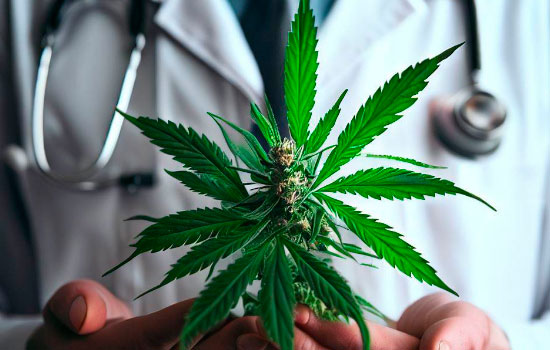Medical marijuana has steadily gained acceptance as a potent relief for chemo-induced nausea, among other therapeutic uses. However, it is crucial to recognize that, like any medication, it is not free from side effects. A paradoxical twist emerges when some patients, rather than finding relief, experience increased bouts of nausea and vomiting. Notably, doctors in Switzerland have identified that up to 6% of patients presenting to emergency departments with recurrent vomiting have it because of cannabinoid hyperemesis syndrome. This raises several pivotal questions: Can marijuana cause nausea? What are the side effects of medical marijuana that one should be aware of? And how can one effectively manage nausea from marijuana? Throughout this article, we will delve deep into understanding these issues, offering insights into managing marijuana nausea and the complexities of the relations between marijuana and appetite.

How does medical marijuana affect the digestive system
Medical marijuana is recognized for its therapeutic benefits, including its effects on the digestive system. However, like any medicinal product, its outcomes can vary based on several factors. The effectiveness of medical marijuana in nausea relief tends to vary based on its form and strain. For instance, flowers and concentrates were observed to be superior in providing relief when compared to tinctures and side effects of marijuana edibles (up to 96% of users experienced relief). Moreover, products labeled as Cannabis sativa and “hybrid” strains demonstrated a higher efficacy in combatting nausea than those labeled as Cannabis indica. If you need professional medical consultation to have a clear picture of different types of cannabis products, join our community of holistic approach enthusiasts and contact a medical marijuana doctor. Now, let’s explore common side effects.
Nausea, appetite stimulation, and appetite loss as common marijuana side effect
Marijuana, while heralded for its therapeutic benefits, is not without its suite of side effects. Just as its compounds can alleviate specific symptoms, they may also introduce others. One of the most discussed and experienced aspects in this regard involves its relationship with the digestive system, particularly nausea and appetite changes.
- Nausea after Smoking Marijuana. Smoking might induce nausea for some users, separate from the effects of marijuana.
- Cannabinoid Hyperemesis Syndrome. Chronic marijuana use in susceptible individuals might lead to this syndrome, characterized by recurrent nausea, vomiting, and abdominal pain.
- Appetite Stimulation. One of the most recognized side effects of marijuana is its ability to stimulate appetite. The ability of marijuana to increase appetite has been beneficial for patients undergoing treatments that suppress hunger. While most might experience heightened hunger, it doesn’t universally apply to all users.
- Marijuana Appetite Suppressant. Paradoxically, while marijuana can act as an appetite enhancer for some, others might experience a decrease in hunger. Certain strains or products could serve as marijuana that suppresses appetite, although this is less commonly reported.
However, the side effects of medical marijuana rarely only to the digestive system. It’s crucial for potential users to approach their consumption with a well-informed perspective. You may learn more about the possible side effects of medical marijuana in our article “Is marijuana safe and effective as a treatment?”
Nausea after medical marijuana
Now, let’s take a closer look at nausea after medical marijuana, especially cannabinoid hyperemesis syndrome. Cannabinoid hyperemesis syndrome is considered a long-term side effect of marijuana as the severity of the condition develops over time. Even though the mechanism of its appearance remains somehow unclear, some theories appear. For example, continuous and prolonged cannabis consumption is considered the sole identified trigger for Cannabinoid Hyperemesis Syndrome (CHS). Interestingly, not every long-term cannabis user develops CHS, suggesting that genetic factors might influence its onset.
Why do you feel nausea after using medical cannabis
One prevailing hypothesis surrounding CHS is that the persistent excessive activation of the body’s endocannabinoid receptors eventually impairs the body’s ability to regulate nausea and vomiting. If you are from Baton Rouge and want to receive professional consultation, do not hesitate and book your appointment. We also provide medical marijuana cards in your area, so you could be able to receive high-quality therapy.
What are the stages of CHS
CHS typically progresses through three distinct phases, each characterized by a unique set of symptoms.
- Prodromal Phase. This initial stage might persist for several months and, in certain instances, even years. It primarily affects early middle-aged adults who began marijuana use during their teenage years. Key symptoms of this phase encompass:
- Discomfort in the abdomen
- Anticipation of or fear of vomiting
- Predominant nausea after smoking marijuana, especially in the mornings
- Notably, actual vomiting is not experienced during this phase.
- Hyperemetic Phase:
In this phase, individuals suffer from persistent and sometimes overpowering marijuana nausea and vomiting episodes. It is challenging to remain productive when you experience such symptoms, so here you can find a list of advice about how to change the situation for the better. Accompanying symptoms for this phase include:
- Persistent dry heaves
- Reduced food consumption leading to marijuana appetite suppressant effects
- Aversions to specific foods
- Heightened anxiety levels
- Clear, watery vomit due to the absence of solid foods in the stomach
- Distinct abdominal pain
- Weight reduction
- Dehydration risks
An unusual yet defining symptom: a compulsive desire to bathe in hot water as it provides relief from the nausea from marijuana.
- Recovery Phase
This is the period where symptoms begin to diminish, and the individual starts to recuperate from the effects of CHS. Proper cannabinoid hyperemesis syndrome treatment during this phase can expedite recovery and alleviate the long-term side effects of marijuana.
How to prevent nausea after weed
While cannabis has been hailed for its anti-nausea properties, particularly for chemotherapy patients, some individuals might experience the paradoxical effect of marijuana nausea after its consumption. Preventing and managing this side effect is crucial for ensuring therapeutic benefits and maintaining a positive cannabis experience.
- Start Low and Go Slow. Especially for novices or those trying a new strain, it’s wise to begin with a small dosage. This lessens the risk of nausea from marijuana and allows the individual to gauge their body’s response.
- Choose the Right Strain. Certain strains might be more conducive to nausea after smoking marijuana than others. Conduct research or consult a cannabis expert to choose strains known for their anti-emetic properties. What is the difference between different strings? We have covered it in our article “What is Indica? The Pros and Cons of Sativa vs. Indica”, which will give you a general understanding of their properties.
- Opt for Vaporizing Instead of Smoking. While both methods involve inhalation, vaporizing is often gentler on the lungs and throat, which may mitigate potential nausea. Be wary of the side effects of smoking marijuana and consider alternative consumption methods.
- Monitor Your Hydration. Dehydration can exacerbate feelings of nausea. Ensuring adequate water intake before, during, and after cannabis use can help prevent discomfort.
- Avoid Mixing with Alcohol. Alcohol and cannabis combined can increase the likelihood of feeling nauseous or dizzy.
- Pay Attention to Your Diet. On an empty stomach, the effects of cannabis can be more pronounced. Eating a light, balanced meal before consumption can help stave off marijuana nausea.
This advice will help you to reduce the risk of the appearance of marijuana nausea. However, talking about CHS, these steps are certainly not enough. Unfortunately, the only way to beat cannabinoid hyperemesis syndrome is to quit medical marijuana therapy completely. Look for medical advice to receive a correct diagnosis of your conditions.

Appetite stimulation after medical marijuana
For many individuals, the therapeutic properties of medical marijuana extend beyond pain management and mood regulation. It’s known to have a pronounced impact on our appetite, with marijuana often hailed as a potent marijuana appetite stimulant. This has been particularly beneficial for patients undergoing treatments like chemotherapy, where appetite suppression is a common side effect.
For the majority of medical cannabis users, appetite enhancement poses no issue and can indeed be therapeutic. Yet, it’s essential to note that approximately 4.7% of patients experiencing side effects of medical marijuana report symptoms explicitly related to increased appetite. As with all treatments, it’s crucial for patients to be aware of potential marijuana side effects, including how it might influence their hunger cues and dietary habits.
Why do you feel appetite increase after using medical cannabis
When patients turn to medical marijuana, one of the noticeable effects they might experience is an increase in appetite. This phenomenon, colloquially referred to as the “munchies,” is primarily driven by specific compounds found within the cannabis plant.
Tetrahydrocannabinol, commonly known as THC, is often cited as the principal component responsible for this effect. This cannabinoid is instrumental in producing the sensation of hunger post-consumption. Does marijuana increase appetite? Studies say it’s primarily due to the presence of THC in many strains. However, THC isn’t the sole agent in the equation. With marijuana and appetite being a subject of keen research, more details are emerging about the synergy of various cannabinoids.
Apart from THC, animal studies have highlighted another cannabinoid, cannabigerol (CBG), which might also play a role in marijuana’s appetite-stimulant properties. While THC remains the dominant force in this realm, it’s essential to recognize that cannabis is a complex plant, housing more than 100 active chemicals. These intricate interactions contribute to the varied experiences individuals have concerning marijuana’s increased appetite effects.
How to prevent appetite stimulation after weed
Understanding the link between marijuana and appetite can help users find ways to counteract unwanted hunger pangs. Here are some strategies to consider:
- Opt for Low-THC Strains. The primary driver behind the surge in appetite post-cannabis consumption is THC. If you aim to avoid this, consider strains with lower THC content. Such strains may not trigger the same degree of hunger.
- Mindful Eating Practices. If you find yourself feeling ravenous after cannabis use, engage in mindful eating. This technique involves fully focusing on the act of eating, recognizing genuine hunger cues, and pausing before indulging to assess if you’re starving or just reacting to the appetite-stimulating effects of marijuana.
- Healthy Snacks. If you’re inclined to eat post-consumption, ensure you have healthy snacks on hand. This can mitigate the potential for overeating or choosing unhealthy options.
- Cannabis Consumption Methods. It’s also worth noting that different methods of consumption can affect how one experiences the side effects of marijuana. For example, the side effects of marijuana edibles might differ from those of smoking or vaping. Experiment with different methods to see which one minimizes appetite stimulation for you.
If you are in the Alexandria area and experiencing munchies, it is always a good idea to seek medical attention to solve this inconvenience. With Louisiana Medical Marijuana Doctors, you will receive professional advice and, if it is needed, adjustment of the dosage or type of cannabis products you are currently consuming.
Appetite suppress after medical marijuana
The interplay between medical marijuana and the physiological processes of the body is a field of constant exploration. While many associate cannabis with the infamous “munchies”, implying an increase in appetite, it might come as a surprise to some that certain strains and components of marijuana can function as a marijuana appetite suppressant. For a subset of users, instead of a heightened sense of hunger, they experience a reduced desire to eat post-consumption. This phenomenon throws a different light on the broader spectrum of marijuana side effects.
Why do you feel appetite loss after using medical cannabis
Navigating the myriad side effects of medical marijuana can sometimes be challenging. A salient component contributing to this appetite-reducing effect is tetrahydrocannabivarin (THCV). When consumed in low dosages, reach with THCV strains can act as marijuana that suppresses appetite. This is in stark contrast to the widespread perception of THC as a compound that invariably does marijuana increases appetite.
Additionally, the interplay between marijuana and appetite is further influenced by other cannabinoids. CBD (cannabidiol) and CBG (cannabigerol), for instance, serve as negative allosteric modulators of CB1 receptors. In essence, rather than amplifying the activity of these receptors as THC would, CBD and CBG can subtly dampen their responsiveness, potentially leading to nausea from marijuana or a diminished appetite.
Complementing the effects of cannabinoids are terpenes, specifically limonene and humulene. These aromatic compounds, while contributing to the plant’s characteristic scent, have been identified to possess appetite-suppressing attributes.
If you are in the Metairie area and suspect that you have some unwanted side effect or, oppositely, interested in appetite-suppressing properties of marijuana – it’s a good cause to start cooperating with LAMMD. Our platform is rich with resources, ready to help you and provide needed information.
How to prevent appetite loss after weed
The therapeutic landscape of medical marijuana is vast and varied, encompassing everything from pain relief to mental well-being. However, like all medicinal interventions, cannabis has its side effects of medical marijuana. Thus, for those grappling with unintentional appetite loss due to cannabis, it becomes essential to adopt strategies that counteract this specific marijuana side effect.
- Strain Selection. Opt for strains that lack or have a lower concentration of marijuana appetite suppressants. Doing thorough research or consulting with a cannabis dispensary can guide users towards strains known for appetite stimulation.
- Timed Usage. Administering marijuana away from meal times might mitigate the immediate nausea after smoking marijuana and appetite suppression some users experience.
- Try an Alternative Form of Remedie. Sometimes, the side effects of smoking marijuana can be different from those of edibles or tinctures. If one route causes appetite suppression, considering an alternative might be beneficial.
- Combine with Natural Appetite Stimulants. Foods like ginger, certain herbal teas, or even spices like black pepper can naturally stimulate appetite and counteract the appetite-reducing effects of certain strains.
- Monitor Dosage. High doses can amplify side effects of marijuana. Reducing the dosage or spacing out the use can help in managing unwanted effects, including appetite suppression.
- Stay Informed on Cannabis Hyperemesis Syndrome. While not directly related to appetite suppression, awareness of conditions like this, which can cause nausea and vomiting, is essential. Appetite suppression might be an early sign of CHS. Knowledge aids in early detection and intervention.
Conclusion
Throughout this article, we’ve explored the intricate relationship between medical marijuana, nausea, and appetite. We’ve understood that while cannabis offers significant therapeutic benefits, it also comes with its own set of side effects of marijuana. Nausea, whether it’s marijuana withdrawal nausea or nausea after smoking marijuana, and the dichotomy of appetite—either stimulation or suppression—are concerns that users may face. Understanding these effects, from the nuances of strains and compounds like THC and CBG to conditions like cannabinoid hyperemesis syndrome, is paramount in ensuring that the therapeutic journey with cannabis is both informed and effective.
Louisiana Medical Marijuana Doctors (LAMMD) prides itself on its unique approach to patient care. Our philosophy stems from the belief that individualized care, rooted in education and awareness, is crucial. We’re not just about prescribing; we’re about educating, empowering, and guiding our patients toward optimal health outcomes. The world of medical marijuana is vast, but with the proper guidance from institutions like LAMMD, the journey becomes more straightforward and more beneficial. If you’re considering medical marijuana as a treatment option, obtaining your MMJ card with LAMMD ensures that you’re not only getting access but also a wealth of knowledge and support tailored to your needs.






